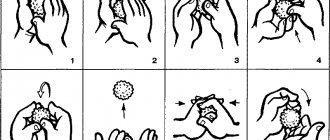Why doesn't the baby fall asleep on his own?
There are circumstances that prevent babies from going to bed on their own:
- Painful sensations. Colic, irregular bowel movements, and teething prevent the child from falling asleep.
- Habit. Bedtime routine is important for babies. And if they constantly rock or sing songs before going to bed, the newborn strongly associates falling asleep with usual actions. Without them, the baby does not understand that he needs to sleep.
- Fear. The baby is familiar with the mother's smell and heartbeat even before birth. They are strongly associated with a feeling of security. Deprived of his usual surroundings, the baby is left alone and begins to be afraid.
- The baby is not tired. Long daytime sleep, insufficient number of walks, lack of outdoor games at home leads to the fact that the energy reserve is not used up. The baby does not feel tired, and therefore does not want to sleep.
If you find out the exact reason for the reluctance to go to bed, it will become easier to teach your child to fall asleep on his own.
The effective method of William Sears
Before using this method, parents must determine that the child is truly ready to fall asleep on his own. Certain signs indicate this. If a woman has stopped breastfeeding or breastfeeds her newborn no more than once a day, then she can proceed with the procedure.
If your baby sleeps for 5 hours at night without waking up, then he can be taught to fall asleep on his own. This procedure is carried out only after the baby has teeth, at least the first incisors, molars or canines. Otherwise, the sleeping child will feel pain and require help from his mother. It is necessary to approach the procedure if the baby is awake in his arms for no more than 1/3. First you need to teach your child to stay in the room alone. If it is played without disturbance for 10 minutes or more, then the baby can be trained to sleep independently.
In most cases, a child’s psychological readiness for independent sleep is observed at 1.5–2 years. At this age, children love to be read to. A bedtime story is a very good ritual that helps separate sleep and wakefulness. During the reading period, parents can lie next to the baby. After reading a book, you need to come up with any reason to get out of bed. It must be taken into account that the reason must be significant for the baby. Before going to bed, your child must say good night.
You should not try to put your baby to bed early, as these attempts are unsuccessful in most cases . Parents should be prepared for the fact that their child may come into their room to sleep. The reason for this may be poor health or poor sleep. To prevent nighttime adventures, parents should escort the child to their room as gently as possible. Very often, for this purpose, mom and dad resort to tricks: they ask the baby to bring a pillow or blanket from his room. If nothing bothers the baby, he will go to his bed, lie down on it and fall asleep again.
It is strictly forbidden to leave a child in a crib if he is crying. This is a stressful situation, since the baby cannot understand why mom is in the next room, but not with him. If the parents are fast asleep or the house is very large, then it is necessary to install a baby monitor in the child’s room.
At what age should you teach
In the first months of life, when the foundation of the psyche is formed, you should not separate the baby from yourself. A newborn should feel the protection that the mother's body gives him. Early learning to fall asleep on your own will only do harm.
But already at the age of 6-8 months, the baby is considered old enough, and you can begin to teach the child to fall asleep on his own. And a one-year-old baby is absolutely ready to rest in his own bed.
How to teach a child to fall asleep on his own?
Do you know what Independent Falling Asleep (SF) is and what the process of putting your baby to sleep looks like when he can fall asleep on his own? Do you know how to teach a child to fall asleep and at what age this can be done?
Often, when parents mention SZ, they immediately have many contradictions and associations with harsh methods, crying alone. The Sleep, Baby team wants to share their experience with parents and debunk the myths and fears associated with the topic of sleep training or sleep training in this article.
What is falling asleep on your own?
Independent falling asleep or, in short, SZ is falling asleep in which the baby falls asleep on his own or with minimal help from his parents in 15-20 minutes in his crib or his parents’ bed (if the parents deliberately chose to sleep together).
The process of putting babies who have already mastered the SZ skill to sleep looks like this:
- Parents perform a bedtime ritual
- Putting the baby in the crib
- Kiss him
- They say "Sleep, baby"
- Turn off the lights and leave
- The baby falls asleep on his own in his crib in 5-20 minutes
All healthy children over 6 months of age, who are both breastfed and bottle-fed, can master the SZ skill. The task of parents is to help their child master this skill.
Children can master the SZ skill themselves, gradually, without the active help of their parents. In everyday life this is called “outgrow”. But, as with any skill, with the help of parents, learning is faster and more effective.
Let's give an example with the “speaking” skill. If a parent does not help the child learn to speak, actively talk to him, praise him, motivate him to speak, the child will still speak sooner or later. But, most likely, without the participation of the parent, the baby will speak later, and perhaps will not speak so confidently and well. It's the same with sleep. Sooner or later, all children will learn to fall asleep on their own, because no one puts us adults to bed in the evening. But if parents do not help their children with sleep training, then difficulties with falling asleep on their own can continue up to three or four years, and in some cases even until school age.
Why is it necessary to teach your child to fall asleep on his own?
The inability to fall asleep without the active help of mom or dad is one of the reasons for frequent night awakenings. One of the reasons, but not the only one. In our pyramid of causes of poor sleep, there are other reasons - problems with the baby’s health, the emotional state of the mother, and the conditions in which the baby sleeps and the routine.
In our individual work with families, it most often happens that after adjusting the sleep schedule and conditions, forming positive associations for falling asleep, the baby’s sleep becomes much better. Parents are satisfied with the results and do not continue work on sleep, the final stage of which is teaching the baby SZ. Several night awakenings of the baby do not bother the parents much, and we do not insist on continuation. Learning to fall asleep on your own is not necessary. If parents are happy with everything, then there is no need to change anything.
If you are happy with everything, then you don’t need to change anything.
But it also happens that even with a comfortable sleep schedule and conditions, the baby continues to wake up often, every sleep cycle - 40 minutes. The child requires the parents' help to fall asleep again. But such intermittent, “dotted” sleep cannot be of high quality and will quickly lead to the accumulation of lack of sleep in the entire family. In such a situation, mastering the skill of sleep is simply necessary, because it is the inability to fall asleep without the help of adults that leads to such frequent awakenings.
Children who have mastered the SZ skill fall asleep easily and cope with short-term awakenings without the help of their parents and wake up only for feeding.
VIDEO LESSON
How to teach yourself to fall asleep on your own?
More details
Methods for teaching yourself to fall asleep independently
In order to teach a child to fall asleep without the active help of adults, many techniques have been invented and described. All methods remove “negative associations” for sleep and help the child learn to calm down and fall asleep without the help of his mother. The techniques can be divided into hard “let cry” and soft “no cry”. Each method has its own application and justification. The main thing is not to rush into application, choose a technique that corresponds to your situation and philosophy of parenting.
The “Sleep, Baby” team strongly recommends choosing gentle methods. But there are objective situations when the use of harsh methods is justified.
Any technique works if you follow it. If you start a technique, and then quit after a couple of days, then start again out of fatigue without preparation, then you are teaching the child to cry, not to sleep.
Be prepared that teaching SZ is never without tears. The baby will resist the usual way of life and express his protest in the only way available to him - by crying. What influences the success of training:
- Rested and prepared child
- Relax and be prepared to follow your own rules
- Find help
- Mindset – visualize success!
How to teach your baby to fall asleep independently?
Teaching your child to sleep on his own is not difficult. Most often, the entire process takes no more than a month. But it is important to understand that at each age there are certain features of teaching SZ.
0 – 6 months
Don't be too hasty in implementing sleep training techniques before the age of 6 months. There are numerous studies that prove that learning to sleep before the age of 6 months causes unnecessary stress for mother and baby and does not guarantee that the skill will be preserved when the baby experiences the first sleep regression.
You shouldn’t demand too much from a baby before 6 months, but you can take the first steps in preparation for mastering the skill after 4 weeks:
- Use different ways to calm your baby, don’t teach him just one way to calm him down.
- Don't rush to get help - give it a chance to find a way to calm yourself
- Sometimes put your baby in the crib sleepy but not asleep
6 months – 2 years
When the child is 6 months old, the first regression is over, lactation has already been established, and the baby is already old enough to master the skill of falling asleep without the help of adults. We believe that this is the most ideal age to accustom a child to SZ. It is important for parents to carefully choose a method of teaching them to fall asleep independently and carry out preparations.
What is important to consider when teaching children aged 6 months to 2 years:
- Sleep training is preceded by preparation; do not start sleep training right away.
- Consistency and consistency of action is the key to your success!
- Choose a time to start the program and get the green light from your doctor
Over 2 years old
Teaching SZ to children over 2 years of age can be challenging. Bad habits for falling asleep are well established, and the baby’s experience suggests that parents give up sooner or later. At this age, children from time to time begin to test their parents’ rules “for strength” - this is how new sleep problems sometimes arise. Babies at this age are very mobile and where they sleep can become an additional challenge.
If your baby sleeps in a bed that is easy to get out of, such as a bed without sides or with a side board removed, or a parent's bed, this complicates the sleep learning process!
Motivation and interest are the main tools in working on sleep with children over 2 years old:
- Use your imagination and take your child as an ally
- Your favorite hero or the Dream Fairy can become participants in the process and perform a controlling function
- Use motivators such as a poster with stickers and small gifts
- The main thing is to finish what you start!
How to prepare your baby to fall asleep on his own?
In any business, preparation and attitude are important. In the process of preparing a baby for SZ there are 6 steps:
- Safety and Sleep Conditions. Safety first!
To reduce the risk of choking, check the safety of your baby's sleeping environment. Learn more about this in our free webinar. Pay attention and tidy up your sleeping conditions. Numerous studies prove that sleep hygiene directly affects the duration and quality of sleep in children and adults. Darkness, silence, oxygen flow, humidity, comfortable temperature and clothing are your “sleepy helpers.”
- Rituals for sleep and awakening.
To switch from active wakefulness to sleep, the baby needs rituals. Rituals are calm, repetitive actions before daytime and nighttime sleep. Choose rituals that mother and child like and devote time to rituals - 30-40 minutes in the evening and 15-20 minutes in the afternoon. Wake-up rituals help the child differentiate between short-term awakenings at night and the time of getting up in the morning. Show your child that morning has come - add light, sing a morning song, hugs, stretches and kisses - all this will make the morning joyful and help the child navigate time.
- Sleep and Wake mode.
A comfortable sleep and wakefulness mode will help you avoid overwork and lack of sleep, which means you will have a restful and high-quality sleep. Our Video Lessons by age .
- Feeding and Sleeping.
Chaotic night feedings and falling asleep only on the breast tire not only the mother, but also the child. Our Video Tutorial will help you put feeding in order and reduce the number of night awakenings. How to separate food and sleep?
- Sleeping in a separate bed.
Did you consciously choose to co-sleep? Or do you put your baby in your crib because otherwise he simply won’t sleep? Be that as it may, SZ training is more effective in a separate bed. The gradual transfer of the baby to his crib is an important stage; you can read how to make it soft and less stressful for everyone in our article Transfer to your crib.
- Help with falling asleep.
How do you help your child fall asleep? Is this motion sickness? Maybe a fitball? Feeding? Singing? All those familiar ways that help a child calm down and fall asleep become associations for falling asleep or sleep habits. Your assistance to your child in falling asleep should be gradually reduced. How to do this in our video tutorial How to get rid of bad sleep habits.
And the last, final step will be the transition to the use of sleep training techniques. If you encounter any difficulties during the process, choose the Video tutorial How to teach your baby to fall asleep on his own
Free webinar Sleep, Baby “Falling asleep on your own: which method to choose?”
Self-Falling Sleep TrainingSleep FrequentWaking UpSleep Conditions
QualitySleep AssociationsDream
Optimal conditions for sleep
Before you teach your baby to fall asleep on his own, you need to properly organize your resting place. It is important to pay attention to the main factors:
- Temperature in the room. There is no need to heat the room above 18-22 oC. The heat will prevent your child from sleeping peacefully. If the temperature in the room in summer rises above this level, you should discard the blanket and put a minimum of clothing on the baby.
- Humidity. The ideal figure is 40-60%. You can achieve the specified humidity level using a special device.
Noise also affects a baby's sleep. But if newborns are able to wake up only from loud sounds, older children can even hear a working TV.
Whether it is possible to teach a child to fall asleep independently with little noise or whether silence is needed directly depends on the sensitivity and temperament of the baby.
Doctor Spock's universal technique
If a child at 5 months does not sleep well, then he can be taught to fall asleep on his own using Dr. Spock’s method. In accordance with it, the baby is placed in his crib and told that he should sleep with his teddy bear, bunny, etc. At this age, the child may not understand what is being said to him, but evaluates the behavior of his parents, which in the future should become a kind of ritual. You should not put your child to bed earlier than his usual time - in this case, the baby will be capricious.
Initially, the child will express his protest. Despite this, the baby must be put in bed, told about toys, turn off the lights and leave the room. Newborns cannot immediately fall asleep on their own.
That is why parents need to periodically enter the baby’s room. In the first days, the child must be checked every minute. Gradually, the time spent visiting the children's room should increase.
If a baby is developing normally at five months, he will wake up for a few seconds a couple of times a night. If, when the baby opens his eyes, he sees that the situation in the room has not changed, then he closes them and continues to sleep. If his parents previously taught him to fall asleep in a stroller or near his mother’s breast, then teaching the child to sleep independently will be quite difficult, but still possible.
Known methods for teaching yourself to fall asleep independently
Many psychologists and pediatricians have conducted research on children's sleep. Based on the data obtained, special techniques for falling asleep independently have been developed. All of them require an adult to be methodical - teaching a child to sleep on his own is quite difficult.
Estiville method
Professor Estiville, who devoted his life to the study of children's sleep and its disorders, at the end of the 20th century, developed a special technique that helps mothers teach their babies to fall asleep on their own to this day. The doctor believed that after six months a baby with a healthy psyche could:
- relax without a light source, including popular night lights;
- go to bed with joy;
- being alone in your own bed and falling asleep without the participation of your parents.
The duration of healthy children's sleep at night, according to Professor Estiville, is 10-12 hours. During this period, the baby’s body will completely rest.
The first thing a mother needs to do is surround him with familiar things. This could be a favorite pacifier or toy.
Then you need to put the child in the crib and explain that the mother wants to teach him to fall asleep on his own. You need to speak quietly and calmly.
Next, you will need to leave the baby, leave the room and then return exactly 1 minute later. This will show the mother that she has not gone anywhere and is still close to the child. You can’t pick him up or rock him to sleep, just walk up to the crib. Then you need to increase the absence time to 3 minutes and repeat the exit with a similar duration 2 times. And extend the interval to 5 minutes.
A similar scheme is used on the first day of using the equipment. Every day the mother's absence time increases by 2 minutes. On the second day, you should start with a three-minute absence, then go out twice for 5 minutes and gradually increase the time to 7 minutes. For the following days, adhere to the following detailed schedule of absence intervals:
- 5-7-7-9-9…
- 7-9-9-11-11…
- 9-11-11-13-13…
- 11-13-13-15-15….
At first you won't be able to sleep peacefully. You should expect children's tears and whims. However, gradually the baby will understand that his mother does not abandon him and is always nearby. Afterwards, your child will not have to wait long to fall asleep on his own.
Fading Method
It is easier to teach a baby to fall asleep on his own with formula feeding. The baby adapts to the regime and more easily weanses the constant presence of the mother. There are more difficulties when breastfeeding. The child gets used to falling asleep while eating. In such cases, it is worth resorting to the Fading technique. The technique involves a long and gradual weaning from falling asleep on the mother's breast.
Additional Information
Most parents think that immediately after they leave the children's bedroom, the baby will fall asleep. But this is far from true: almost all children begin to cry and call for their parents. In some cases, hysteria may occur. This indicates that the child is fighting for his own comfort. If parents hear a child crying, they wait a short period of time and still rush to help the baby. After this behavior from mom and dad, the child understands that his plan worked. In this case, this simple technique will be constantly used.
In this case, parents are recommended to use the stopwatch method. With its help, the baby can learn to sleep independently as comfortably as possible. After leaving the room, parents need to time three minutes. If during this period the child continues to cry, then you need to go into his room. At the same time, taking the baby out of the crib or picking it up is strictly prohibited. You need to talk to the baby, wipe his tears and calm him down. After wishing pleasant dreams, the parents leave the room again, only for 4 minutes.
If the child does not calm down, then you need to repeat it - go into the room, calm the baby down and leave. After each exit from the room, the waiting mode should be extended by a minute.
It is strictly forbidden to calm the child down by screaming, as this may frighten him even more. Parents should speak softly and tenderly. According to statistics, on the first day the child will fall asleep after 12 to 15 visits to the room. On the second day, the time the parents are absent must be increased by one minute. This time you will have to enter the room only 5 - 6 times.
Teaching a child to sleep on his own is quite difficult, but it is quite possible. Parents just need to be patient, and after a few weeks there will be no need to rock the baby to sleep.
Ways to teach your baby to fall asleep independently
Universal rules have been developed, following which will help speed up the habit of falling asleep on your own:
- Daily bedtime ritual. This includes washing your face and brushing your teeth. You can turn it into a game or sing a lullaby. It is important that the actions are repeated daily.
- Same laying time. Choose a convenient time and regularly send your child to bed no later than the set time. The baby should sleep no later than 10 pm.
- Surrounded by familiar things. A favorite teddy bear, car or pacifier will help your baby fall asleep faster.
Do not put children in the same bed as adults. Babies should sleep in their own separate place.
Falling asleep ritual - from birth
- Same bedtime .
- The same words accompanying the ritual of going to bed (“now go to sleep”, etc.).
- Repetitive actions and their order : put on a diaper - sang a song - put on pajamas (swaddled) - lay down in the stroller (crib).
- Same place of installation . It is advisable to use this place only for sleeping, so that the child has a strong association with sleep.
- A sleepy toy is a positive stimulus for sleep.
Advertising
Why you need to teach your child to fall asleep on his own
If the baby cannot fall asleep without the help of his parents, then there is no need to talk about healthy sleep. Night awakenings between sleep phases, typical for children, should be short-term. Otherwise, we can talk about lack of sleep, which negatively affects the psyche in the formation phase.
If you teach your baby the skill of falling asleep independently, he will be able to easily tolerate the absence of his parents nearby. This is important, because mom will go to work and will not spend much time outside the home.
Teaching your baby to sleep on his own - why is this necessary?
Content
There are many reasons to encourage you to start learning to sleep independently, and the main one is that the child should be accustomed to adult life, and some doctors recommend doing this in infancy. Another important reason that needs to be taken into account is that parents have more free time. You can spend it on household chores that cannot be done with an awake baby, or just relax quietly.
An important reason to teach a baby to fall asleep on his own is habit - the baby gets used to motion sickness and with age it becomes increasingly difficult to get him to sleep without additional incentives. Children quickly develop unwanted skills, which take a lot of time to get rid of.
Baby doesn't fall asleep without mom: consequences
If a child a year or older is not able to go to bed independently, this can lead to slower emotional and physical development. The consequences of sleep disturbances in childhood manifest themselves at an older age in the form of:
- nervous disorders and neuroses;
- mental disorders;
- emotional instability;
- inability to cope with stress.
A baby's inability to go to sleep on his own can have dangerous consequences. Lack of sleep weakens the body's immunity: the child gets sick more often, and his performance decreases. That's why sleep training is important for both babies and mom and dad's peace of mind.
Create a bedtime ritual
What is a ritual? This is a sequence of several actions that are repeated each time under the same circumstances. Observance of rituals has a calming effect on children. They make the child’s world predictable and understandable, and therefore safe.
At first, it may not be enough to simply kiss your child good night or read him a fairy tale. The younger the child, the more detailed and lengthy the ritual before falling asleep should be.
It is important that an hour before going to bed the child is not overexcited and is in a calm environment. Dim the lights, turn off the TV, and do not play active games with your baby. The choice of activities that will be included in the ritual of falling asleep depends on what your child likes and what has the most calming effect on him. It can be:
- Lullabies;
- Fairy tales;
- Music for relaxation;
- Motion sickness;
- Feeding;
- Bathing;
- Teeth cleaning;
- Massage;
- Quiet games;
- Toy cleaning;
- Putting a toy to sleep;
- Discussion of impressions received during the day.
An example of a daily ritual before bed: bathing, brushing teeth, rocking to sleep, putting down your favorite toy, reading fairy tales. The sequence of actions included in the ritual is very important in order to put the child to sleep without tears. It must remain unchanged, otherwise you risk encountering whims and hysterics. You may feel that following a ritual every day takes too much time. However, often the ritual of falling asleep includes those actions that you already perform every day (for example, bathing or feeding), you just have to develop a certain sequence. In addition, this is a wonderful opportunity to enjoy communication with your child.
You can start preparing for bed as soon as you notice that your baby is tired. It is important not to miss this moment, because if the child is already overexcited and begins to act up, there is no point in carrying out lengthy rituals. In this case, immediately proceed to the final steps of the ritual.
Tips for children from one to two years old
What we are writing about are general examples of how to teach a child to fall asleep on his own, which in each family should be adapted in their own way, since yours will be special, who, if not you, knows your baby better - what he likes , what can calm him down, what he needs. Simple things can help you fall asleep:
- Bathing. Most children find baths soothing, especially those with good herbs. But there are children who get excited from bathing, from the smell of shampoo, from the fact that delicate children's skin can be irritated by water. Observe your child's reaction to taking a bath. You can also skip shampoos and use soothing essential oils (again, if you don't have allergies).
- Massage. Children love a gentle massage; it can have a calming effect before bed. You don’t need knowledge of any special techniques here, just feel your baby, find out by observing his reactions - what he likes most, where he becomes silent, where he becomes more active. After the bath, stroke him along the entire body, affectionately and very gently, from the top of his head to his toes. After the massage, put him in warm pajamas, this may already be the first signal for sleep.
- When the first teeth begin to appear, brushing your teeth can become part of the evening ritual of going to bed, and, by the way, it is useful for the educational process. Brush your teeth until a full row appears with a cotton swab.
- Silence. An hour before falling asleep, do everything softly, speak quietly, the light should be dim. If you put on a disc with music or a fairy tale, it is very quiet. So attention will develop, the child will have to listen to words, and he will be less active.
- Fairy tales. They should be kind, without scary and evil heroes that they might dream about later. It is better to read a fairy tale in a monotonous voice and even swaying a little; practice shows that in this rhythm the baby begins to nod off. On the other hand, there are active children who follow with great curiosity the development of the plot and dialogues, which are read by their mother in different voices. If your child is interested, you can motivate him by telling him such interesting tales every evening before he falls asleep.
- Favorite toy. A doll, a bear, an elephant - it doesn’t matter, as long as it is a toy that has become a friend, clinging to which you will not feel lonely.
- Light source. If you see that your baby is afraid of the dark, do not leave him alone with stress. Buy a night light, glowing stars for the ceiling, something else that will make it clear that he is not alone, but is safe. There is an example of one mother who came up with the idea of placing a fear trap in front of her baby’s room at night, and in the morning releasing these fears out the window. Such things are very good for the child’s peace of mind, and therefore a restful sleep.
- Habits. You yourself can create habits that will become both pleasant communication with your mother and a signal for your child to fall asleep. For example, your baby loves to have his back scratched or his legs stroked at night, or is used to back counting rhymes that are well known to us like “Rails, rails, sleepers, sleepers...” The child can accurately draw the connection between how his mother makes “rails” ” and then he will say: “Now it’s time to sleep.”
- Communication. Dad can be very involved in the process of falling asleep. Firstly, it is customary to respect dad, and secondly, the child really needs daddy’s affection, so he gains confidence that dad will always protect. Therefore, dad can complete mom’s rituals, talk to the baby for a few minutes, stroke, kiss and say: “Now it’s time to sleep.”
From 6 months to 2 years
A technique that allows you to cope with the child’s need for the proximity of his parents when falling asleep after six months implies a gradual separation of the mother from the baby. The process is quite simple - try to move a little away each time you lay the baby down. The main thing is not to stop communicating or singing lullabies. Move the chair on which the mother sits closer to the door every time she puts her son or daughter to bed. A prerequisite is to send the child to bed only after signs of early sleep are noticeable. The baby yawns and rubs his eyes - a sure signal to start an experiment, which will certainly end with positive results after some effort.
When studying ways to teach a child to fall asleep on his own, you should definitely pay attention to another interesting technique proposed by the American pediatrician Pentley. The doctor recommends changing the baby’s usual associations - going to bed much earlier, preventing the child from overtiring.
Instead of the usual mother, who is always nearby, put your favorite toy and explain in a calm, confident tone that now there will be a hedgehog or a bunny nearby. At first, it is better to prepare for children's tantrums - the child will be reluctant to be left alone with the toy. Mom should always be nearby and come to the rescue at any moment - talk, calm, stroke. The baby will certainly get used to falling asleep, knowing that a loved one is always nearby. Learning to fall asleep on your own usually takes 3-5 weeks.











